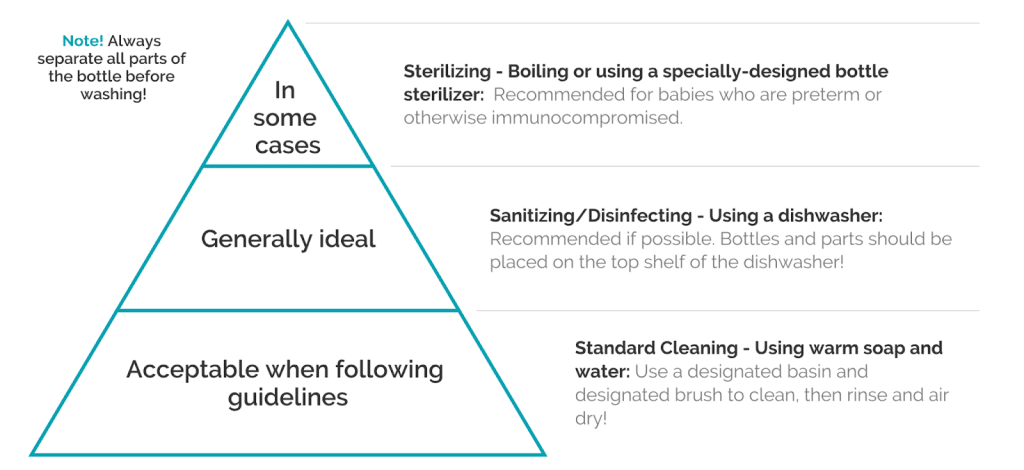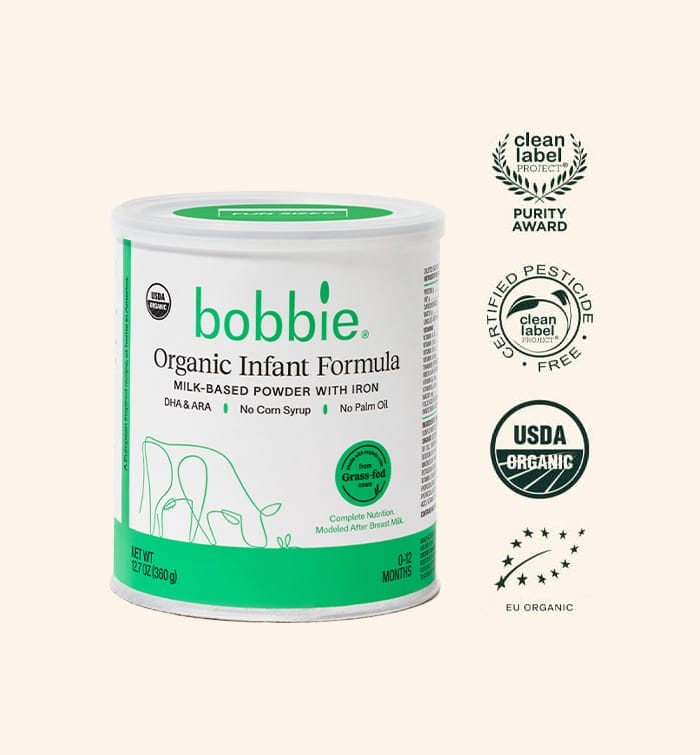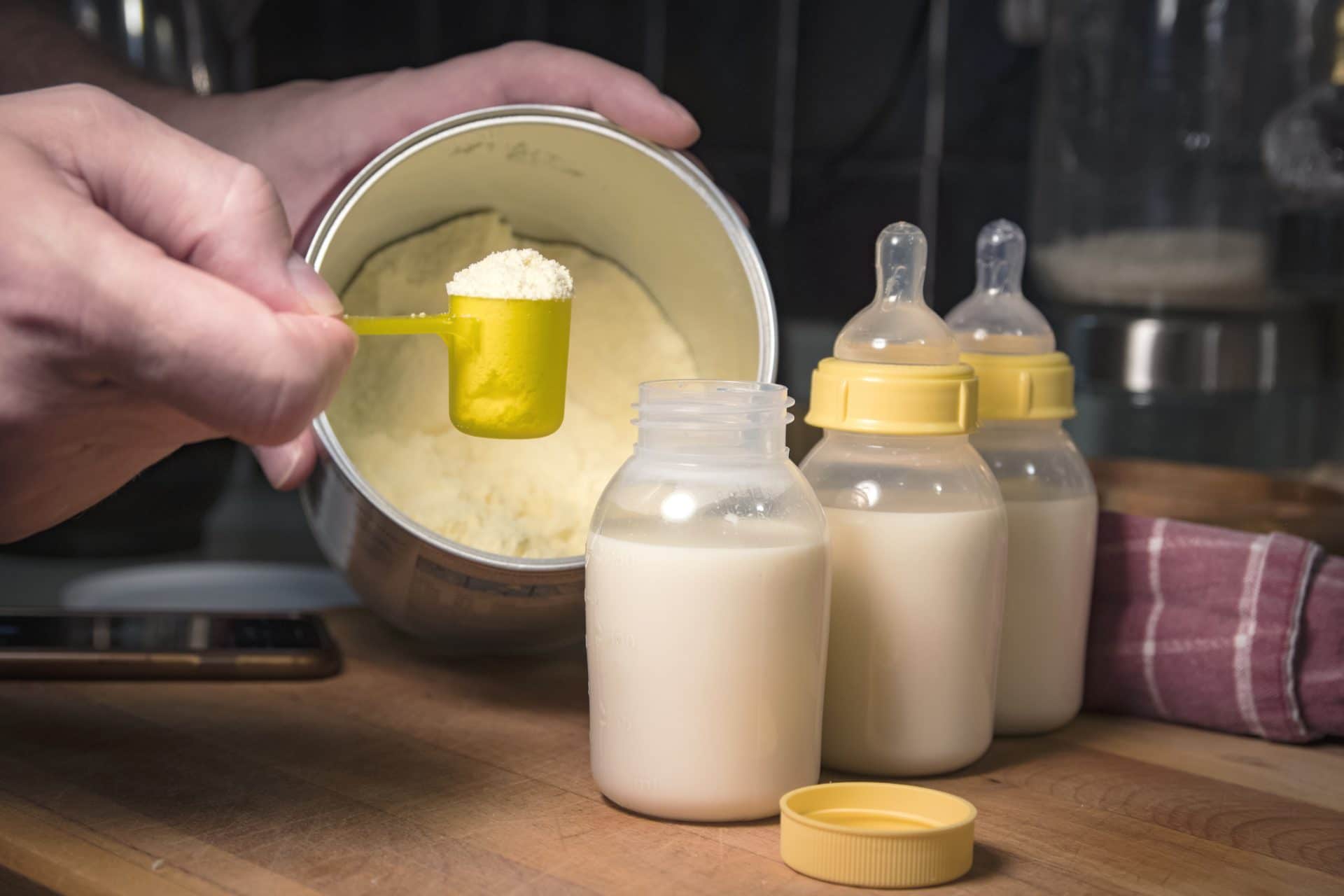We are proud to say that these posts are not sponsored. Our editorial team of Bobbie moms and writers personally select each featured product. If you buy something through our links, we may earn an affiliate commission, at no cost to you.
Whether you’re a new parent or already have one or more little ones running around your feet, you could have questions about how to prepare baby formula. It may sound straightforward, but having questions on baby formula preparation and storage is expected for any parent. It easily becomes confusing since infant formula comes in several different types: powder, concentrate, and ready-to-feed, each with its own unique preparation methods.
For each type of formula, it’s important to follow the instructions exactly to prevent fluid, electrolyte, and nutritional imbalances that can happen with improperly made formula. The good news is that once you do it a few times, knowing how to make a formula bottle becomes second nature, and any anxiety there may have been will fade away. (This is true with so many aspects of parenting!)
Follow along as we go through the basics of how to become a great baby bottle maker.
How to make a baby formula bottle
Depending on the formula you use, the methods for making your baby a bottle can be quite different. Here are the basic instructions for making a bottle with powdered, liquid concentrate, and ready-to-feed formulas.
For all types, follow these instructions first before preparing your bottle for the formula.

- Sterilize bottles, nipples, and caps before using for the first time. There are many ways to sterilize baby bottles— from boiling water to using an electric bottle sterilizer. Find the method that works best for you.
- You’ll want to sterilize your bottles more often if your baby is younger than 3 months, was born prematurely, or has a compromised immune system. Once their immune system is more developed, washing with hot soapy water and air drying is a good way to keep bottles clean.
- Wash your hands – Powdered formula is NOT sterile. The best thing you can do to avoid bacterial contamination is to wash your hands before making a bottle.
- Clean and disinfect the surface you’re working on.
- Make sure you read the instructions on the container, as each brand can have varied instructions.
- For powdered formula and liquid concentrate: If there is any safety concern about your water, boil water for one minute, then let it cool for 5 to 30 minutes. Water can be filtered tap or bottled water. It must be potable (safe, drinkable water). If you’re not sure, check with your local health department.
- Don’t add anything! – Unless specifically advised by your pediatrician, never add rice cereal, oatmeal, or baby food to your baby’s bottle. Prebiotics, probiotics, and vitamin D drops may be added safely according to the individual packaging instructions.

Shop Bobbie Organic Infant Formula
Bobbie Organic Infant Formula is a USDA Organic, EU-style infant formula that meets all FDA requirements. It is a complete nutrition milk-based powder modeled after breast milk and is easy on tummies. It is non-GMO and doesn't have corn syrup, palm oil, or maltodextrin. Learn more about Bobbie.
How to Prepare Infant Formula from Powder
Remember! Powdered infant formula is not sterile. Families of infants who are premature or who are immunocompromised should consult with their child’s doctor before using powdered formula.
- Wash your hands – The best thing you can do to avoid bacterial contamination is to wash your hands before preparing a bottle!
- Measure the desired amount of cooled water into the bottle first and add powder to the water second. Always add the water first to ensure the correct amount is used. The typical ratio for U.S. formulas is one level, unpacked scoop of powder for every 2 ounces of water. Only use the original scoop that comes with the can and follow the directions on the container.
- Use level, unpacked scoops! Scoops should be brought up from the container and leveled with a clean knife. Do not repeatedly tap the scoop as this will cause the formula to pack! *Don’t try to measure half a scoop. Without using a food scale, there is no way to determine you are getting exactly half the grams of formula in the scoop. Doing this may change the nutritional content in your baby’s bottle. If you need an odd number of ounces, round up to the next even number and then pour the extra ounce into a spare bottle. Stash it in the fridge and use it for the next feeding!
- Stir, swirl, or shake. Use a mixing pitcher or a clean knife to stir the formula to dissolve. If your baby is gassy you may want to avoid shaking the bottle to mix as this can as it causes bubbles and foam to form which can lead to excess gas for your baby!
How to Make a Concentrated Formula Bottle
This infant formula comes as a concentrated liquid, meaning it’s typically double the strength of what your baby should drink. You must dilute this formula with water.
Since all you have to do is pour the formula and water into a bottle, it’s a bit easier, neater, and more convenient than powder. But, it also tends to be more expensive. To prepare:
- Shake the bottle of concentrated formula well.
- Pour the proper amount of formula into the bottle– typically you’ll use equal parts water and formula but be sure to read the directions. For example, if making a 4 oz bottle, usually you will add 2 oz of the formula concentrate to 2 oz of water.
- Attach the nipple and cap to the bottle and shake well.
How to Use Ready to Feed Formula
Ready-to-feed infant formula is the easiest option as there’s no mixing and no measuring of parts needed. This product is available in various sizes, from 2-3 oz bottles to 6-8 oz cans or tetra-paks and even 32 oz containers. Ready-to-feed formula is often the most expensive since it’s ready to serve.
Since there is no mixing required, the steps to prepare it are simple:
- Shake the can of formula.
- Pour the desired amount of the ready-to-feed formula into a bottle.
- Attach the nipple and cap, shake, and it’s ready to go.
What Type of Water to Use for Baby Formula
Powdered and liquid concentrate formulas must be mixed with water–but what kind of water is best for baby formula? Can you use tap water for baby formula?
Per the A.A.P., you can use tap water as long as you’ve confirmed that the water source is safe through your local health department or state government agency. If your water source has fluoride added, occasionally mix in low-fluoride bottled water to avoid dental fluorosis– a condition where lacy white markings cover tooth enamel.
If your tap water is not safe for drinking, boiled water, (which is sterile), is recommended. Regardless of if your water is deemed “safe”, if your baby is under 3 months old, has a weakened immune system, or was born prematurely, you’ll want to boil water from any source before mixing it with formula to kill any germs that could make your baby sick.2 Boil the water, let it cool for 5 to 30 minutes, then mix the cooled boiled water with the formula.
Once your baby is older than 3 months and is not at high risk for infection, you can skip boiling the water. Some babies prefer warmed bottles to cold, so if your baby fusses with a cold or cool bottle, just warm it slightly by running hot water out of the tap over the bottle or use a bottle warmer.
If you plan to use bottled water, use gallon distilled water without fluoride. Nursery water is an expensive marketing ploy- your infant formula has all the nutrients your baby needs! Generic gallons of distilled or purified water are fine.
How to Warm a Bottle
Many babies prefer warm formula, but some like it on the cooler side. Either temperature for a bottle is safe. You can warm your baby’s bottle by holding it under hot running tap water, placing it in a bottle warmer, or in a container of warm water for 5-10 minutes.
Never microwave formula. It can affect the ingredients and cause hot spots in the fluid which may burn the baby’s mouth. Remember to test the temperature of the formula by placing a few drops on the inside of your wrist to protect your baby’s mouth from burns. It should feel warm, not hot.
How Long Formula is Good For
You may be wondering, “How long is baby formula good for?” The answer: it depends!
Bottles
- 24 hours – Prepared, unused powder formula can be safely stored in the fridge (37 degrees or cooler) for up to 24 hours. Unused ready-to-feed formula can be stored in the fridge for up to 48 hours or as directed on the packaging.
- 2 hours – Prepared, unused formula can be kept at room temperature for up to 2 hours.
- 1 hour – In order to prevent bacterial growth, formula must be discarded within 1 hour after feeding begins. NOTE: Unused formula may be offered again at the 50 minute mark before tossing!
For more detailed information on baby formula storage guidelines, check out this post!
Formula Containers
Safety starts with the formula container itself. Follow these easy directions to make sure your formula is stored so that it stays fresh and safe for your baby.
- Check the expiration date on the formula can before opening it. If it’s expired, or if the can is dented, bulging, or leaking, throw it out.
- Opened cans or containers of powdered formula should be stored in a cool dry place and should be used within 30 days of opening.
- Once open, concentrate or ready-to-feed formula can be stored in the refrigerator for up to 48 hours.
- Store unopened cans in a cool, dry, indoor location but not in the refrigerator or freezer.

Shop Bobbie Organic Infant Formula
Bobbie Organic Infant Formula is a USDA Organic, EU-style infant formula that meets all FDA requirements. It is a complete nutrition milk-based powder modeled after breast milk and is easy on tummies. It is non-GMO and doesn't have corn syrup, palm oil, or maltodextrin. Learn more about Bobbie.
Baby Formula Preparation and Storage FAQs
Can you use cow’s milk instead of baby formula?
No. Regular cow’s milk is not suitable nutrition for a baby under a year of age. Cow milk-based formula, however, has been modified to include the exact amount of nutrients a baby needs. Adding milk to a bottle instead of water would change the composition of the formula and could lead to nutrient deficiencies.
Can you mix breast milk and baby formula?
Yes, you can combine breast milk and prepared formula together in the same bottle. Some reasons you may be interested in doing this is if you’re transitioning your baby from stored breast milk to formula feeding or have a low milk supply and need to supplement with formula (but don’t want to waste two bottles!).
If you mix breast milk and baby formula in the same bottle, you must first make the formula with the correct water-to-formula ratio before adding breast milk. Otherwise, your baby won’t receive the proper mix of water, electrolytes, protein, vitamins, and minerals. You can mix ready-to-feed formula directly with breast milk.
Can you add extra water to increase formula quantity?
You may be tempted to stretch your baby’s formula by adding extra water, but doing this could be dangerous for your baby. Adding any additional amount of water to formula can slow your baby’s growth and development and disrupt their electrolyte balance, leading to seizures, according to the American Academy of Pediatrics.
Can you batch prepare baby formula to fill several bottles at once?
If you’d like to prepare formula in advance, you can make individual bottles or use a formula pitcher or other type of batch maker. Please follow the below instructions:
- Label each bottle with the date and time that the formula was prepared.
- Refrigerate the extra bottles until you need them up to 24 hours after mixing the formula.
- A note on temperature– formula can be served warm, room temperature, or straight from the fridge! Warming formula to body temperature is not required. If you do warm your bottles, do not use a microwave, as it can create ‘hot pockets’ in the formula and potentially burn you or your baby! When heating formula, always check the temperature of the formula on the inside of your wrist before offering it to your baby.
Preparing baby formula
Powdered baby formula, liquid concentrate, and ready-to-feed formula all provide essential nutrition for your little one, and each one has its own set of rules when it comes to safety.
From washing the bottle to boiling (or not boiling) the water, getting the temperature right, and mixing the formula– there’s a lot to making a bottle safe for your little one. Thankfully, along with everything else in motherhood, once you do it a few times you’ll be a pro at keeping your baby nourished and healthy.
Not sure which type of formula is best for your baby? Learn more about how to choose between powdered, liquid concentrate, and ready-to-feed formulas.
Verified by: Kelsey Lorencz, RDN

